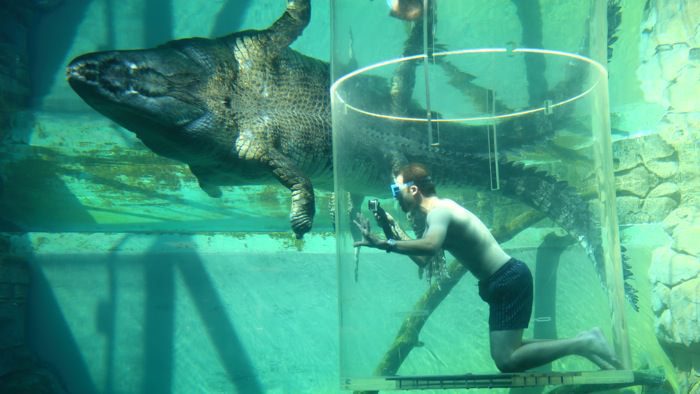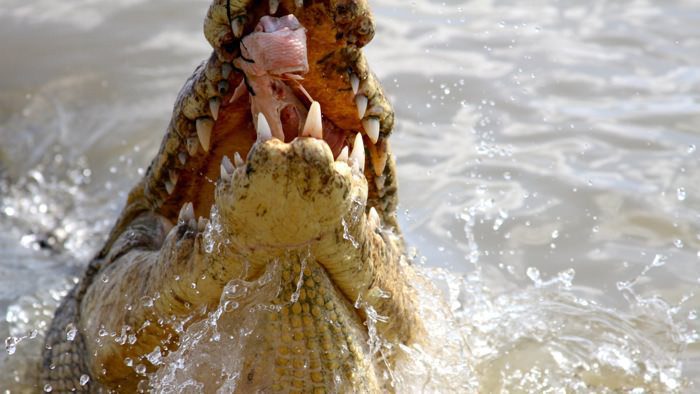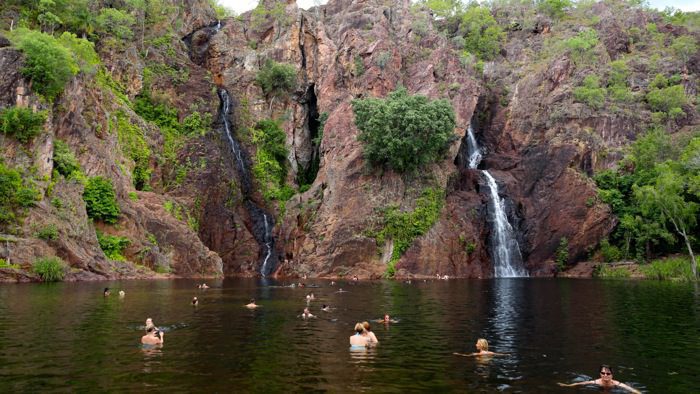Australia’s Northern Territory is a vast expanse of land with a variety of landscapes and eco systems. The Top End of the Northern Territory is a particularly good starting point for visitors who want to experience the NT’s unique culture, tropical weather, and see its notorious giant saltwater crocodiles.

As the capital, Darwin is the largest city in the sparsely populated Northern Territory. Residents of Darwin are diverse, with roots in Aboriginal, Greek, British, Malaysian, Indonesian, and Chinese cultures. Whether you’re headed to the Northern Territory to see Uluru-Kata Tjuta National Park, Kakadu National Park, or just plan to stick around Darwin for a few days, you will be spoiled for choice.
The NT is an adventure and nature-lover’s dream destination. Here is an overview of what you can do, see, and eat in and around Darwin.
The Darwin Waterfront is a beautifully renovated precinct of town where families come to enjoy the balmy climate and cool off all year round. The area offers several shopping and dining venues, as well as beautiful ocean views. Since Darwin’s beaches are crocodile zones, residents have ingeniously created a safe swimming area, the Wave Lagoon (open daily 10 a.m. – 6 p.m.), which offers ten types of waves as well as a shallow toddler pool for the little ones. The Wave Lagoon also has shaded areas and lounge chairs for sun tanners.

The Stokes Hill Wharf is an integral part of the Darwin Waterfront – a place for al fresco dining and the chance to learn about the history of Darwin during WWII. Despite being destroyed by Japanese bombs on February 19, 1942, the wharf is still in use by local fishermen and jet boat operators. It’s a great place for a casual meal and sunset views. From April to November the open-air Deckchair Cinema (along Jervois Road) operates every night of the week, featuring an array of Australian and foreign films. The city provides the chairs and kiosks have food and drinks for sale, but you can bring your own picnic if you like. The cinema opens at 6:30 p.m. and the films start at 7:30 p.m. Admission is $15 per adult.

The Darwin Waterfront is currently undergoing a massive renovation, along Kitchener Drive, but you can still access it via the Skywalk and the Smith Street East Walkway. Other sights around the Darwin Waterfront include the oyster-shaped Darwin Convention Centre, Parliament House, WWII Tunnels, and cultural art installations along the Smith Street East Walkway.
Nowhere else in Australia can you get up close and personal with the country’s epic saltwater crocodiles, or “salties.” Crocosaurus Cove in the heart of Darwin city is home to the largest collection of Australian reptiles on earth. Among its residents are over 70 native species to the Top End and six of the largest captive crocs in the world. Visitors will get the chance to see amazing turtles, lizards, snakes, and unique fresh water fish.

Crocosaurus Cove is also home to the world famous Cage of Death – the only cage in the world that brings people safely face to face with the giant salties of the Northern Territory. A Plexiglas cage is lowered into a crocodile enclosure while the croc is fed by staff members. The result for the brave souls inside Cage of Death is an unforgettable feeling as the croc snaps down with the strongest bite force of any other animal on the planet.

Other activities at the park include fishing for crocs, turtle feeding, big croc feeding, and having your picture taken while holding a baby croc. Crocosaurus Cove is also a fantastic learning experience that the whole family can enjoy, and it’s location smack center in Darwin City along Mitchell Street.
The region’s tropical weather allows Darwinians to spend a lot of time outdoors. The city’s market culture is thriving thanks to the several nationalities residing here. Asian, European, and local gastronomies are well represented at the local food markets, which gives everyone the chance to sample several types of foods in one place. All markets are free to enter and great for people of all ages.

The Mindil Beach Sunset Market (Thursday 5 – 10 p.m. and Sunday 4 – 9 p.m. May to October) is renowned for its pleasant atmosphere and good selection of food, dessert, handicrafts, and art stalls. Arrive in time to catch the beautiful sunset and feast on local and international treats such as kangaroo burgers and Vietnamese spring rolls. Local bands often entertain the crowd for tip money.

Another great market to visit is the Parap Village Market (Saturdays 8 a.m. – 2 p.m. all year, rain or shine), one of the city’s longest-running markets. Parap is the perfect place for breakfast or lunch. Try delicious authentic Malaysian Laksa, fresh fruit smoothies, hot crepes, gourmet coffee, or pick up some locally grown fresh produce. Parap Village Market is also a great place to shop for fresh flowers, artwork, beauty products, handmade jewelry, and souvenirs. Live music gives it a lively atmosphere. Come early to avoid the midday heat.

Getting out of Darwin to see other areas of the Top End will open your eyes to how diverse the flora and fauna really is. One of our favorite experiences was a day trip to Litchfield National Park with Wallaroo Tours. After an amazing cruise to see the jumping crocs of the Adelaide River, we were transferred to Litchfield National Park to see giant termite mounds, waterfalls, and to swim in the natural freshwater pools of Wangi Falls. Lunch was included and our send-off was a lovely sunset toast with champagne and prawns for the whole group. The crocodile cruise and Litchfield trip departs every day from March to December. Hotel pick up and drop off is included.

Another great option is to visit Australia’s largest protected area, Kakadu National Park. Located 250 kilometers from Darwin, Kakadu is listed as a UNESCO World Heritage Site for is diverse habitats and abundance of Aboriginal rock art. Kakadu is the ideal place for birders, nature lovers, and outdoor enthusiasts alike. The park boasts over 1,000 plant species and is home to one-third of all Australian bird species. Kakadu was literally carved out of the earth by several rivers: Mary, Wildman, West Alligator, South Alligator, and East Alligator. The Aboriginal rock art at the Ubirr and Nourlangie Rock Sites demonstrates the enduring Aboriginal connection to nature.

Other attractions in Kakadu include the Gunlom Plunge Pool with epic views of the southern part of the park, the Bowali Visitor Centre, the awe-inspiring Jim Jim Falls, and the Yellow Water Billabong, which is home to crocodiles, birds, and fish. If you plan to stay the night at Kakadu, there are several three and four-star accommodations in the area. The crocodile-shaped Gagudju-Crocodile Holiday Inn is truly unique!

Getting here: There are several ways to travel to the Northern Territory, by car, bus, air, rail, or sea. The NT is serviced by several highways, making self-driving and bus transport possible. Darwin has an international airport with flights daily to/from every mainland Australian capital city. Darwin also has direct flights to/from Singapore, Philippines, and Indonesia. For those traveling by rail, the Ghan provides regular service from Adelaide to Darwin with stops in Alice Springs and Katherine. Cruise ships are now frequenting Darwin in their itineraries, as are expedition cruises.
When to visit: The best time to visit is during the dry season (May through October). The weather is hot and humid year-round.
Do’s and don’ts: Darwin and the surrounding areas of the Northern Territory are home to several species of reptiles, with the saltwater crocodile being at the top of the food chain. Never stand on river banks, clean your fish close to shore, or swim or wade in the rivers, creeks, or beaches. These crocodiles are highly territorial and aggressive. The Northern Territory is also home to mosquitoes, venemous snakes, and other potentially dangerous animals. Use mosquito repellent and your common sense (don’t disturb the animals you see or wander from clearly marked paths). Wear hiking boots, a hat, sunscreen, and take plenty of drinking water with you everywhere you go – It gets hot!
It is our hope that you make the time to experience the wonder of the Northern Territory at least one in your lifetime. The culture, gastronomy, and nature of Darwin and the surrounding areas is the ideal getaway for the discerning nature-loving traveler.
Do you have any favorite places/ recommendation in Darwin or the Northern Territory? Tell us about it! Leave a comment below.
For more information on tourism in the NT and Top End, visit the Tourism Northern Territory website.